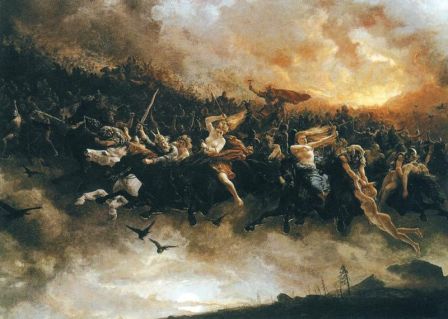Queen of elphame
Goddess Nicneven
Filed under: Goddess Spirituality
October 31, 2012

“The Faery Godmother” by Brian Froud
“Nicneven’s themes are protection, ghosts, divination, peace and winter. Her symbols are pumpkins, gourds and traditional Halloween fare. In Scotland, Nicneven is the crone Goddess of Samhain, which is the predecessor of modern Halloween festivals. Nicneven governs the realms of magic and witchcraft and also represents the imminent onset of winter.
In magic and Celtic traditions, this is the new year – a time when the veil between worlds grow thin and spirits can communicate with the living. Follow the usual customs of carving a pumpkin or turnip for protection and to illuminate the way to family spirits to join you in today’s celebrations.
In Druidical tradition, Samhain was a time to rectify any matters causing dissent. Nicneven provides the magical glue for this purpose. Take a white piece of paper on which you’ve written the reason for anger in a relationship, then burn it in any hallowed fire source (the pumpkin candle, or ritual fires). As you do, ask Nicneven to empower the spell and destroy the negativity completely.
To inspire Nicneven’s wisdom or magical aptitude within, enjoy traditional Halloween fare – apple pie, for example, brings sagacity. Sparkling apple cider tickles magical energy. And root crops provide solid foundations and protection while magical creatures are afoot!
(Patricia Telesco, “365 Goddess: a daily guide to the magic and inspiration of the goddess”.)

“Queen of the Bad Fairies” by Brian Froud
Nicneven or Nicnevin or Nicnevan (whose name is from a Scottish Gaelic surname, Neachneohain meaning ‘daughter(s) of the divine’ and/or daughter(s) of Scthach‘ NicNaoimhein meaning ‘daughter of the little saint’) is a Queen of the Fairies in Scottish folklore. The use of the name for this meaning was first found in Montgmeries Flyting (c.1585) and was seemingly taken from a woman in Scotland condemned to death for witchcraft before being burnt at the stake as a witch. In the Boreders the name for this archetype was Gyre-Carling whose name had variants such as Gyre-Carlin, Gy-Carling, Gay-Carlin amongst others. Gyre is possibly a cognate of the Norse word geri and thus having the meaning of ‘greedy’ or it may be from the Norse gýgr meaning ‘ogress’; carling or carline is a Scots and Northern English word meaning ‘old woman’ which is from, or related to, the Norse word kerling (of the same meaning).
She was sometimes thought of as the mother witch, Hecate, or Habundia figure of Scottish fairy mythology. This guise is frankly diabolical. Sis Walter Scott calls Her:a gigantic and malignant female, the Hecate of this mythology, who rode on the storm and marshalled the rambling host of wanderers under Her grim banner. This hag (in all respects the reverse of the Mab or Titania of the Celtic creed) was called Nicneven in that later system which blended the faith of the Celts and of the Goths on this subject. The great Scottish poet Dunbar has made a spirited description of this Hecate riding at the head of witches and good neighbours (fairies, namely), sorceresses and elves, indifferently, upon the ghostly eve of All-Hallow Mass. In Italy we hear of the hags arraying themselves under the orders of Diana (in Her triple character of Hecate, doubtless) and Herodias, who were the joint leaders of their choir, But we return to the more simple fairy belief, as entertained by the Celts before they were conquered by the Saxons.
Alexander Montgomerie, in his Flyting, described Her as:
Nicnevin with Her nymphes, in number anew
With charms from Caitness and Chanrie of Ross
Whose cunning consists in casting a clew.

“The Wild Hunt: Åsgårdsreien” by Peter Nicolai Arbo
Even so, the elder Nicnevin or Gyre-Carling retained the habit of night riding with an ‘elrich‘ entourage mounted on unlikely and supernatural steeds. Another, satirical popular depiction made Her leave Scotland after a love-quarrel with Her neighbour, to become wife of ‘Mahomyte‘ and queen of the ‘Jowis‘. She was an enemy of Christian people, and ‘levit vpoun Christiane menis flesche’; still, Her absence caused dogs to stop barking and hens to stop laying. But in Fife, the Gyre-Carling was associated with spinning and knitting, like Habetrot; here it was believed to be unlucky to leave a piece of knitting unfinished at the New Year, lest the Gyre-Carling should steal it.”

“Nicnevin” by Xavier Collette
For a fantastic and in-depth piece written on this Goddess, I highly recommend reading “Nicnevin” by Sarah Lawless over at Witchofforestgrove.com. In her piece, she explains “Nicnevin is the Queen of Elphame, the queen of the fairies, spirits, and strange creatures, queen of the Unseelie Court ofAlba. She reigns with a male consort at Her side, but his name is never given, it is my guess he changes with Her moods. She is the Gyre Carline and appears sometimes in the Scottish tales as Habetrot, a crone-like spirit known for Her magical powers of spinning, weaving and clothmaking. It is said She wears a long grey mantle and carries a white wand and can appear as an old crone or a beautiful young woman. White geese are sacred to Her and their cackling may herald Her arrival. In this we see She is linked with the Germanic Goddess Holda… Hel, queen of the Underworld, the leader of the Wild Hunt in Norse legend.”
In the Encyclopedia of Spirits by Judika Illes, she writes: “Nicnevin, Scottish witch Goddess, can transform water into rocks and sea into dry land. Her name is derived from Gaelic Nic an Neamhain, ‘Daughter of Frenzy.’ Nicnevin flies through the night. Although usually invisible, Her presence is announced by the cacophony of geese. The Romans identified Her with Diana.
Following Scotland’s official conversion to Christianity and brutal witch trials, Nicnevin, a former Goddess, was reclassified as both a Fairy and a demon. (Scotland suffered particularly virulent witch hunts, second in scope only to the German lands in terms of prosecutions and executions.) She is considered Queen of the Fairies of Fife, Scotland and is among the spirits associated with the Wild Hunt.

Sea hag from the hit TV show “Charmed”
Manifestation: Nicnevin manifests as a beautiful woman and a dried out old hag. She wears a long gray mantle.
Attribute: Magic wand
Element: Water
Birds: Geese
Day: Samhain (Halloween) is Nicnevin’s sacred night when She grants wishes and answers petitions. She is traditionally honored with celebratory feasts and toasting. On Samhain, Nicnevin makes Herself visible as She flies through the air accompanied by a retinue of witches and honking geese. Rituals are also held in Nicnevin’s honor on November 1″ (p. 760).
http://journeyingtothegoddess.wordpress.com/tag/queen-of-elphame/

No comments :
Post a Comment